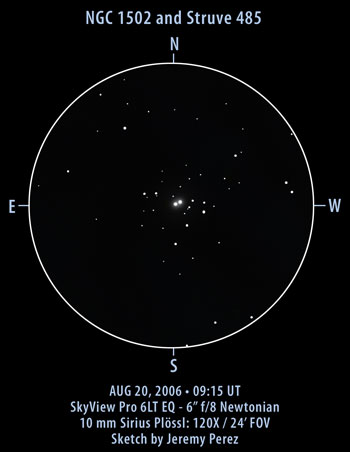
Click on image above for larger version (86K).
Observation Notes:
This little knot of stars was a stop I made while cruising through Perseus, Cassiopeia and Camelopardalis. As I navigated to the area, I ran into Kemble’s Cascade. It was a pleasant surprise–I’m not very familiar with the area yet. At low magnification, the double star at the center stood out immediately. At 120X, this brilliant white double still dominates the view, providing a spectacular heart to the cluster. The magnitudes of these two stars were equal as far as I could tell. The cluster itself is triangular in shape, looking a bit like a miniature head of Taurus with its snout pointing to the west. A couple other very tight, dissimilar doubles showed off near the center of the cluster (you will need to click the sketch above for a larger version in order to make out those tighter doubles). I plotted 33 stars within the general perimeter of the cluster–35 if you count a couple stragglers. The diameter appeared to be about 9 arc minutes.
Factoids
NGC 1502 was discovered by Friedrich W. Herschel in 1787. Located near the southeast end of Kemble’s Cascade, NGC 1502 is sometimes referred to as the pool into which the cascade tumbles.
The brilliant double at the heart of the cluster is Struve 485. According to the Washington Double Star Catalog listing in Vizier, the magnitudes of the pair are listed as 6.93/6.94, with a separation of 17.9″ and a PA of 304°. The Saguaro Astronomy Club Catalog and a number of other sites list magnitudes of 7.0 and 7.1 however.
| Subject | NGC 1502 and Struve 485 |
| Classification | Open Cluster (l 3 m) / Double Star |
| Position* | Camelopardalis [RA: 04:07:49.3 / Dec: +62:19:54] |
| Size* | NGC 1502: 7.0′ |
| Brightness* | NGC 1502: 6.9 vMag. Struve 485: 7.0/7.1 |
| Separation* | Struve 485: 17.9′ |
| Position Angle* | Struve 485: 304° |
| Date/Time | August 20, 2006 – 02:15 AM (August 20, 2006 – 09:15 UT) |
| Observing Loc. | Anderson Mesa, AZ |
| Instrument | Orion SVP 6LT Reflector (150 mm dia./1200 mm F/L) |
| Eyepieces/Mag. | 32 mm (37.5X); 10 mm (120X) |
| Conditions | Partly Cloudy, Calm |
| Seeing | 3/10 |
| Transparency | Mag 6.8+ NELM |
| *Sources | NGC/IC Project |
*Based on published data.
You probably had lots of interest from British viewers as a result of a monthly article by Adrian Berry, (http://www.adrianberry.net)’The February Night Sky’, in The Daily Telegraph.
Here is my input from a Welsh address.
Regards Dennis.
Dennis, thanks very much for your post and for the link. I enjoyed reading the article at The Telegraph and look forward to browsing Adrian’s site a bit later. Thanks for dropping by.
Very best regards,
Jeremy
I was just looking for Struve 485 with my Meade DS-90 at about 40x and 100x when I stumbled across the beautiful field it was in. What a nice surprise and, thanks to your web page, I now realize the field was NGC 1502 at the end of Kemble’s Cascade. Thanks.
Struve 485 and NGC 1502 definitely made a very nice combination. It’s an enjoyable surprise to come looking for a double and stumble onto a cluster, or vice-versa. Thanks for sharing your experience, Al.
Jeremy
Jeremy,
I love the sketches on the website, and in “Astronomical Sketching”. They are perfect to show what an amateur can actually see, in contrast to the astrophotos usually shown which can mislead new observers, and often cause them to be disappointed with their telescopes.
That contrast is one of the things I want to highlight in my “Handbook of the Constellations” which is to be published by Springer this fall. Would you be willing to supply some sketches for this book? I’ll be happy to send more info about the book, and even a completed chapter if you like.
Phil Simpson
Hi Phil, thanks very much. Indeed, one of my goals in creating and showing the sketches here is to provide a sample of what these amazing objects look like visually. I’ve sent an email your way.
Take care,
Jeremy